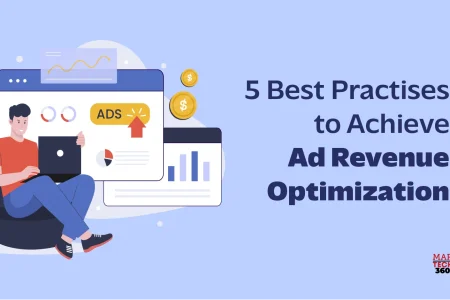Ad revenue optimization is an approach for optimizing the revenue streams generated by every user when displaying ads. Every ad optimization strategy includes evaluation and improvements of various factors that influence the ad performance, like the placements of the ad, ad formats, its quality, target audience, and user experience (UX). The goal of revenue optimization through ads is to have better engagement and click-through rates (CTRs). Marketing teams can achieve this by targeting the right audience with better-quality ads. It helps digital marketers to generate more revenue per ad impression. In this blog, let us have a look at the importance of ad revenue optimization and the best practices to achieve it.
The Importance of Ad Revenue Optimization

Ad revenue optimization is critical for organizations that depend on PPC (pay-per-click) advertising to make revenue. It offers the following benefits for these enterprises:
● Higher ROI
Businesses that optimize Ads can generate more revenue for every penny spent on PPC advertising campaigns. It results in a higher return on investment.
● Better Performance of Ad Campaigns
Improving different aspects of PPC campaigns will assist enterprises in enhancing their advertising campaigns’ performance. This approach is one of the most effective ways to increase the click-through rates of Google Ads.
● Minimized Ads Expenditure
Marketers who are able to optimize ads will minimize their execution costs by targeting more relevant keywords. It also helps in increasing the relevance of the ad and reduces expenditure on low-performing ads.
● Improved Client Targeting
Evaluation of the data gathered from PPC campaigns will offer valuable insights into the target audience’s behavior, demands, preferences, and requirements. Marketers can utilize this data to make more effective ad targeting and increase conversion rates.
Also Read: The Art of Effective Native Advertising: A Marketer’s Guide
Best Practises for Ad Revenue Optimization

Given below are a few strategies that marketing teams can consider to accomplish Ad revenue optimization:
1. Research and Choose Relevant Keywords
Selecting the right keywords is one of the most important factors for revenue optimization through ads. Setting the right keywords for the ads will ensure the displayed ad will appear to the right target audience. It helps marketers to have higher ad impressions, click-through rates (CTRs), and conversions. Here are the top practices that the presales team can consider to improve their keyword research and selection:
- There are various digital advertising tools available that can help advertisers to streamline their work processes. For example, platforms such as SEMrush, Ahrefs, or Google Keyword Planner help digital marketers determine the right set of keywords and their search volumes.
- Focus on long-tail keywords with lesser competition and has the potential to gather more targeted traffic. Ensure that the long tail keyword should be more specific and relate to the product or service.
- Digital advertising professionals should refrain from selecting broad-match keywords that might attract irrelevant traffic that results in wasted ad spend.
- Evaluate the search terms report in the PPC tools to determine which keywords work and eliminate the irrelevant keywords.
2. Optimize the Ad and Creative Copy
Other than the selection of keywords, the Ad and Creative copy play a crucial role in making the programmatic advertising campaign a success. The copies for Google ads need to be interactive, relevant and improved to have increased CTRs and conversions.
The copywriters can use language that provokes the target audience to take action. They can establish clear calls-to-action (CTAs) to improve clicks and conversions. There are a few ad extensions like structured snippets, callouts, and site links that marketing teams can rely on to offer additional information about the products and services to increase ad real estate. It is important to ensure that the copies of the digital advertising have relevance to the targeted keywords and landing pages. Presales teams can execute and test various ad variations to determine which ad copy works best for specific keywords and audiences.
3. Enhance the Design of the Landing Pages
Users, after clicking on PPC ads are redirected to the landing page. The landing page should have an ad copy that engages the audience and encourages them to complete the CTA. Marketers should consider setting a precise and compelling theme for the landing page that portrays the page’s value proposition.
Embedding images and videos to improve the aesthetics of the landing page will help improve the overall performance of the campaigns. Set a provoking CTA that encourages the user to complete the desired action. The majority of the users access the internet through their phones. Hence, it is essential to ensure that the landing pages are optimized for mobile devices to enhance the user experience.
4. Improve the Bid Management Strategies
Bid management helps businesses to determine how much they should pay for every click on their ads. Digital marketing teams can rely on bid management tools with automated bidding. Google Ads’ smart bidding uses machine learning to modify the Ad bids depending on the likelihood of conversion. Modifying the bids depending on the performance of the ads helps to increase the bids for the ads that perform better. This approach helps to reduce the Ad bids on the bottom line. It is crucial to evaluate the competition and make necessary adjustments to the bids to ensure that the ads are competitive during the auction. Marketing teams can consider multiple factors like timing, device, and location to ensure the displayed ad is targeted to the right target audience.
5. Embrace Ad Testing and Experimentation
In order to optimize revenue through ads, it is important to embrace Ad testing and experimentation. This approach allows enterprises to determine the most effective ad composition and targeting segments. Marketing teams can design different ad formats and ad sizes to deploy an A/B testing strategy. It is an effective way to compare the performance of the two different ad variations and stick to the one that drives results. Presales teams can analyze various targeting approaches like audience targeting and location targeting. Embracing experimentation to evaluate the influence of modifications to the PPC campaigns, like bid adjustments and ad copy changes, is essential to track the impact.
Wrapping Up Ad Revenue Optimization
The digital-first landscape has resulted in a paradigm shift in the competitive landscape and demands of the consumer. It is crucial for advertisers to ensure they make the most out of every penny spent on digital advertising programs. CMOs should consider integrating the right tools and implementing the best practices to have ad revenue optimization.

